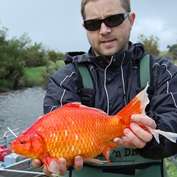Gold rush! First evidence of spawning migration of football-size goldfish

Murdoch researchers have discovered for the first time football-sized goldfish are travelling hundreds of kilometres each year through WA waterways.
This discovery has major implications for controlling the species in south-western WA.
Dr Stephen Beatty and researchers from the Centre of Fish and Fisheries used strategically placed acoustic receivers to examine the movement patterns of an introduced goldfish population in the Vasse River, revealing the population travelled great distances.
"Our research discovered the fish displayed a significant seasonal shift in habitats during breeding season, with one fish moving over 230 kilometre during the year," Dr Beatty said.
Until now, little has been known about the movement patterns of goldfish, which has hampered the development of effective control programs.
"The goldfish population in the nutrient rich Vasse River has existed for over two decades and has the fastest known individual growth rate of this species in the world," continued Dr Beatty.
"The results of this study will have important direct management implications, enabling more strategic development of effective control programs for the species such as targeting migratory pathways."
Goldfish are native to eastern Asia but are now considered one of the world's worst invasive aquatic species, with at least 76 invasive freshwater fish species introduced to rivers in Mediterranean climate regions around the world.
Defined as an alien species introduced to Australian freshwater bodies, goldfish can enter river systems after being dumped from aquariums into catchment lakes. Once the fish become established, their eradication is often difficult, which is having a significant impact on Australian ecosystems.
"Once established, self-sustaining populations of alien freshwater fishes often thrive and can spread into new regions, which is having a fundamental ecological impact and are major drivers of the decline of aquatic fauna," added Dr Beatty.
Dr Beatty said the invasive fish can potentially impact water quality, introduce disease, disturb habitat and compete with native species putting them under serious pressure, which just adds to the existing threats associated with habitat and water quality decline.
The paper has been published in the international journal Ecology of Freshwater Fish.
More information: Stephen J. Beatty et al. First evidence of spawning migration by goldfish (); implications for control of a globally invasive species, Ecology of Freshwater Fish (2016). DOI: 10.1111/eff.12288
Provided by Murdoch University



















